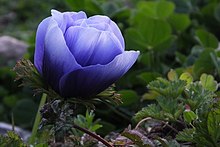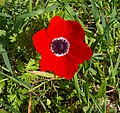Anemone coronaria
| Anemone coronaria | |
|---|---|

| |
| Scientific classification | |
| Kingdom: | Plantae |
| Clade: | Tracheophytes |
| Clade: | Angiosperms |
| Clade: | Eudicots |
| Order: | Ranunculales |
| Family: | Ranunculaceae |
| Genus: | Anemone |
| Species: | A. coronaria
|
| Binomial name | |
| Anemone coronaria | |



Anemone coronaria, the poppy anemone,
Description
Anemone coronaria is a
Aside from its flowers resembling poppies, the red single wild form flowers resemble the flowers of the red single wild form of Ranunculus asiaticus.
Taxonomy
Within the
Etymology
Anemone coronaria means crown anemone, referring to the central crown of the flower, evoking regal associations. The Arabic name is
In
It is a symbol of Palestinians too.[12]
Distribution and habitat

Ecology
In the wild, A. coronaria is winter flowering and cross pollinated by bees, flies and beetles, which can carry pollen over long distances.[3]
Cultivation
Anemone coronaria was introduced into England prior to 1596, being described in
Anemone coronaria is widely grown for its decorative flowers, and has a
Cultivars
Modern cultivars have very large flowers, with diameters of 8–10 cm and a wide range of bright and pastel colours, in addition to two toned varieties. The centre is usually black, but may be pale green in white varieties. Stems may be as tall as 40–50 cm, and each plant may produce 13–15 blooms.[3]
Numerous cultivars have been selected and named, the most popular including the De Caen (single) and St Brigid (semi-double and double) groups of cultivars.[14] The De Caen group are hybrids cultivated in the districts of Caen and Bayeux in France in the 18th century,[4] and include 'Bicolor' (red with white), 'Blue Poppy' (blue), 'Mr Fokker' (purple), 'Sylphide' (deep pink) and 'The Bride' (white). Referred to as poppy anemones because they closely resemble the true poppy (Papaveroideae). St. Brigid cultivars originated in Ireland, and named after that county's saint, they include 'Lord Lieutenant' (purple blue) and 'The Governor' (red).[15] In addition to these large groups, there are two minor groups, Rissoana which is very rustic and early blooming (November) and Grassensis with large double flowers that bloom in the spring.[3]
Gallery
-
Growing wild near Megiddo, israel
-
Red flower
-
Blue flower
-
White flower
-
Purple flower
-
Red flower with 6 petals
-
Scanograph of purple flower
-
In Cyprus
-
Purple anemone in the Judean mountains
-
Red and white anemone
See also
- Wildlife in Israel
References
- ^ BSBI 2007.
- ^ Johnston 2008.
- ^ a b c d e f Laura & Allavena 2007.
- ^ a b c d MBG 2017.
- ^ Hoot et al 2012.
- ^ a b Lane, Edward William (1872). Arabic-English Lexicon. Islamic Book Centre.
- ISBN 978-90-04-13030-2.
- ^ a b c Hitti, Philip K. (1951). History of Syria. p. 117. Retrieved 2 July 2020.
- Hebrew).
- ^ הכלנית: הזוכה בתחרות "הפרח של ישראל", ynet, 25 November 2013.
- ^ staff, T. O. I. "60,000 flock to south where fields torched by incendiary balloons now bloom". www.timesofisrael.com. Retrieved 2 February 2019.
- ISSN 1070-289X. Retrieved 25 January 2024.
- ^ "Anemone coronaria L." Plants of the World Online. Royal Botanic Gardens, Kew. Retrieved 25 September 2021.
- ^ GW 2017.
- ^ Gardenia 2017.
Bibliography
- Hoot, Sara B.; Meyer, Kyle M.; Manning, John C. (1 March 2012). "Phylogeny and Reclassification of Anemone (Ranunculaceae), with an Emphasis on Austral Species". S2CID 85773478.
- Laura, M.; Allavena, A. (1 January 2007). "Anemone coronaria Breeding: Current Status and Perspectives" (PDF). European Journal of Horticultural Science. 72 (6): 241–247. JSTOR 24126221. Archived from the original(PDF) on 18 April 2017. Retrieved 17 April 2017.
- Johnston, Brian (May 2008). "A Close-up View of the "Anemone": Anemone coronaria (De Caen Group)". Microscopy UK. Retrieved 17 April 2017.
- "Anemone coronaria". Gardening help: Plant finder. Missouri Botanical Garden. Retrieved 16 April 2017.
- "List of accepted plant names" (Excel). Resources. BSBI. 2007. Retrieved 16 April 2017.
- "Anemone coronaria (poppy anemone)". Gardenia. 2017. Retrieved 16 April 2017.
- "Anemone coronaria 'De Caen Group'". Gardener's World. BBC. 2017. Retrieved 17 April 2017.










